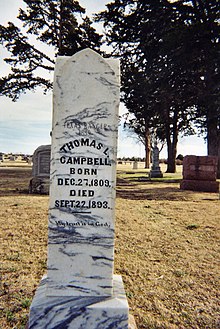Thomas Lopton Campbell Jr.
| Thomas Lopton Campbell, Jr. | |
|---|---|
 |
|
| Born |
December 27, 1809 Oneida County, New York (US) |
| Died | September 22, 1893 (aged 83) Guthrie, Oklahoma |
| Allegiance | United States of America Republic of Texas |
| Service/branch | Texas Rangers, Republic of Texas Militia |
| Years of service | 1839-1861 |
| Unit | volunteer army |
| Battles/wars | Black Hawk War Mexican-American War East Texas Indian War |
Thomas Lopton Campbell, Jr. (December 27, 1809 – September 22, 1893) was a nineteenth-century American pioneer and Texas Ranger. Campbell pioneered the American frontier in New York, Ohio, Illinois, Missouri, Texas, Kansas, and Oklahoma. He fought in the Black Hawk War and served as a Texas Ranger from 1839 until the secession of Texas from the Union. Campbell, along with Texas Governor Sam Houston, was a prominent spokesman for remaining in the Union prior to the Civil War. Targeted as the most widely known Union supporter in the Austin area, on the day Texas voted to secede from the Union Campbell was publicly humiliated on the streets of the Capitol when a crowd of Secessionists held him captive and forced him to "fire" the anvils in celebration of secession. Campbell and his family left Texas the next day to run supply routes for the Union and pioneer lands in Missouri and Kansas. Later, at the age of 79, Campbell would pioneer a claim in the Land Run of 1889 in Oklahoma.
Thomas Lopton Campbell, Jr., was born on December 27, 1809 in Oneida Co., New York. His father, Thomas Lopton Campbell, had served in the War of 1812 and his grandfather, John Campbell of the Argyll Campbells of Scotland, was a soldier in the American Revolution and a member of Clan Campbell. No record of his mother exists but "family tradition in the Henry Clay Campbell family says that either Thomas Sr.'s wife or the wife of ... John Campbell was of Indian blood." After the War of 1812, while Campbell was a boy, his family took flatboats down the Ohio River to pioneer in lands being settled in southern Ohio. The Campbells settled along the west bank of the Hocking River in 1823.
In 1831, Campbell married Clarissa Witter. The Witter family had arrived in America in 1639 and had suffered religious persecution at the hands of the Puritans, fighting for civil liberties in the New World. Thomas and Clarissa were always on the frontier, traveling in covered wagons west and giving birth to 12 children - three sets of twins included.
After their marriage Thomas and Clarissa followed the frontier westward, first to Illinois where Thomas fought in the Black Hawk War, and then to the Republic of Texas. The Campbell family arrived in Upshur County of northeast Texas in early 1839. They had followed the Mississippi River to the mouth of the Red River then up the Red River across Louisiana. They settled on the west fork of Glade Creek about six miles (10 km) North of the Sabine River. Campbell served as a Texas Ranger during the East Texas Indian War in July of his first year in Texas. He subsequently served as a Ranger during the Mexican-American War and when emergencies arose, serving stints of three to six months at a time.
...
Wikipedia
